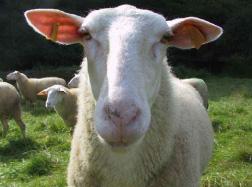L’élevage du Mouton Laitier en Wallonie, un potentiel méconnu
Dairy sheep breeding in the Walloon Region : an ignored potential
-
-

Figure 1: Prevalent system - Table 1: Production and breeding performance of primiparae and multiparae - Figure 2 : Trend for milk production (PL) and milk butterfat content (TB) and protein content (TP) during the production season.

L’élevage du Mouton Laitier en Wallonie, un potentiel méconnu
Previous
Next
Context
Although speculation in sheep for milk production is attracting growing interest from producers and processors in the Walloon Region, no recent in-depth studies exist on sheep rearing for milk production. Such a lack of information on the specific features of this speculation is all the more regrettable as we have a dairy breed which is a threatened local breed that could be considerably more effectively exploited : the Belgian Milk Sheep. Moreover, rearing ewes for milk production, which has a traditional, authentic, local image among consumers, could offer a profitable avenue for diversification of animal production in the Walloon Region.Objectives
The main aim of this project is to set up a database focusing on the specific features and technical nature of sheep rearing for milk production in the Walloon Region. Implementation involved not only measuring ewe production performance (milk production) and breeding performance (reproduction) but also describing the specific rearing techniques involved.Results obtained
Given the nature of this study it was conducted in real conditions on two livestock farms, rather than at the Station, in order to produce a true image of the diversity of situations occurring in the Walloon Region. Each of these farms pursues a different aim : one focuses on producing milk and lambs for meat production, while the other concentrates exclusively on milk production. They are located in different agro-ecological areas, one being in Hesbaye and the other in the Ardennes. A special lactation system is followed in ewe breeding for milk production, with the ewes suckling the lambs for about five weeks before being milked (Fig. 1). To establish the production performance of the ewes in terms of both quantity (milk production) and quality (useful fraction and somatic cell count), official milk recording had to be put in place on the farms taking part in the study. Compared to multiparae, primiparae have a longer suckling period and a shorter lactation period (Table 1). Belgian Milk Sheep have very good breeding performance levels, with prolificacy close on two lambs per lambing ewe. The prolificacy of primiparae is lower than that of multiparae. The milk production trend is illustrated in Figure 2. Daily milk output dwindles as the production season advances, falling from 2 litres per ewe in March to 0.6 litres by October. At the same time, the protein and butterfat contents increase perceptibly, reaching over 7% and 9% respectively by the end of the season. The milk thus becomes increasingly rich as lactation continues. However, concentration of the useful fraction due to the low level of milk production towards the end of lactation is the cause of the sharp rise in levels occurring from August onwards. The absence of a lactation peak in the graph is due to progressive milking of the ewes and also to the fact that production peaks relatively early, around three to four weeks after birth, during suckling. The protein and butterfat content follow a similar pattern during lactation, though with greater fluctuation in the case of the butterfat content. Bacteriological analyses show that tank milk from the two farms meets the standards in force. Mammary infections in the smaller ruminants differ from those in cattle chiefly in their etiology and a lower average incidence of clinical cases. The annual clinical case rate in sheep farming is no more than 5% of all animals, a notably lower level than in dairy cattle. However, the somatic cell count (SCC) in a healthy ewe is perceptibly higher than in the cow, with counts between 500,000 and 1,000,000 cells/ml being generally considered normal. We found that cell counts rise with rank and stage of lactation. Approximately 70 % of the sheep have an SCC under 500 thousand cells and these account for 10 % of the total SCC, whereas 20% of the sheep population make up over 80% of the total SCC. [image]Contribution
CRA-WPartners
Gembloux Agricultural University Louvain Catholic University MR-W, Department of Development and Extension Walloon Interprofessional Federation of the Goat and Sheep Sectors Walloon Livestock Farming Association Milk Committee, Battice CRAW off coordinator
BARTIAUX-THILL Nicole (Inspecteur général scientifique) Rue de Liroux, 8 B-5030 Gembloux Téléphone direct :62 67 71 Téléphone département :+ 32 (0) 81/61.27.39 - 61.27.40 Fax département :+ 32 (0) 81/61.58.68 E-mail :bartiaux@cra.wallonie.be Funding


